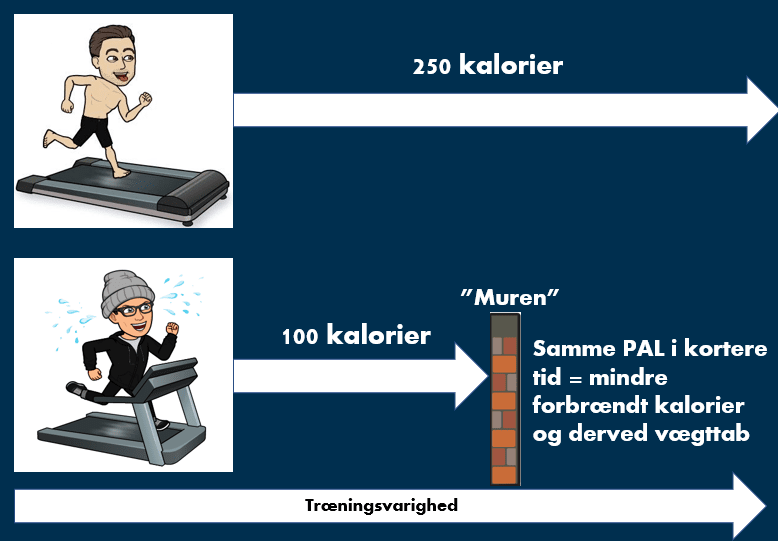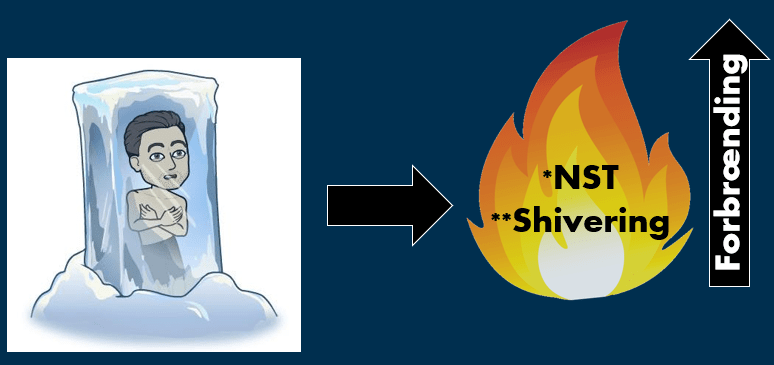I often see people doing cardio, or any other physical activity, with an extra layer of cloth on (or when wrap their stomach) in the faith that the extra sweat will promote higher rates of fast loss. Does this really influence fat loss, or does it hurt?
When there is an inequality between the heat production of the body (from muscle contraction or an external heat production like cloth) and the body heat regulation, then the core temperature will be affected. One of the first responses the body have to an increasing core temperature, is something called Vasodilation, which is an increase in the blood vessels diameter and by that increase the amount warm blood being transported to the skin. This will cause the skin temperature to rise and thereby increase the amount of sweat coming though the sweat gland and onto the skin (2).
Sweat is thereby non equal with weight loss and if it was, I would be in a sauna instead of doing cardio.
Dehydration is decreasing performance (more sweat = less calories burned?)
A result of the increasing sweat rate is a loss of bodyweight, which is mostly coming from water loss and not fat. Water is a big part of the human body (48 ± 6% for women; 58± 8% for men). An extreme sweat production has a negative effect on physical and cognitive performance (3,4). A small decrease in the body’s water content by only 2% by an increase in sweat production will decrease the physical performance by 20% (5) and an even further decrease I water content by only 0.5% will cause an even higher decrease in the performance to a total of 30% (6). The decrease in physical performance will thereby increase the intensity of the cardio which will result in an earlier fatigue. As an result of the earlier fatigue the amount of burned calories will be decreased because the amount of work is less (known as PAL; Physical activity level). Thereby the person who is doing the cardio without the extra cloth will be sweating less, be working for longer with the same relative intensity and therefor burn more calories and lose more fat.

Upregulation of calories burned under cold conditions
In addition to impairment in performance, the body will have an upregulated calories consumption under cold condition. Under cold conditions, the body will use various mechanism, including “Shivering”. Shivering is defined as; involuntary muscle contraction without an external force production. Shivering accounts for most of the involuntary heat production. Shivering like any other muscle activity requires energy. The metabolic costs can increase to 5x depending on the intensity of the shivering (6,7,8). The markedly increased metabolic costs increases the amount of calorie burned.
Furthermore, at cold temperature, increased heat production occurs in the brown fat in humans (9,10). Heat production in the brown fat is a result of “nonshivering thermogenesis (NST)” which increases heat production with creating a contraction (11). NST is a metabolic process that generates heat using energy, there is also an inverse relationship between NST

Conclusion
It is a fallacy to believe that increased sweat production, as a result of cardio or other physical activity with extra clothing increased reduced fat mass. This is contrary to what is happening. As the cold increases the amount of calories being burned, extra clothing has the opposite effect. At least as important, performance is being reduced as a result of extra clothing by the dehydration. This results in a shorter time during which cardio can be maintained at the same intensity which will cause fatigue to happen earlier. Thereby decrease the amount of calorie burned. Since weight loss is a result of calorie deficit, cardio with extra clothing is not desirable. Cardio is a tool for achieving a calorie deficit, which results in weight loss.
References
- Sauna, shower, and ice water immersion. Physiological responses to brief exposures to heat, cool, and cold. Part III. Body temperatures. Kauppinen K Arctic Med Res. 1989 Apr; 48(2):75-86.
- Benefits and risks of sauna bathing. Hannuksela ML, Ellahham S Am J Med. 2001 Feb 1; 110(2):118-26.
- Living, training and playing in the heat: challenges to the football player and strategies for coping with environmental extremes. Maughan RJ, Shirreffs SM, Ozgünen KT, Kurdak SS, Ersöz G, Binnet MS, Dvorak J Scand J Med Sci Sports. 2010 Oct; 20 Suppl 3():117-24.
- Effects of marked hyperthermia with and without dehydration on VO(2) kinetics during intense exercise. Nybo L, Jensen T, Nielsen B, González-Alonso J J Appl Physiol (1985). 2001 Mar; 90(3):1057-64.
- Fluid and electrolyte supplementation for exercise heat stress.Sawka MN, Montain SJ Am JClin Nutr. 2000 Aug; 72(2 Suppl):564S-72S.
- Horvath, S.M. 1981. Exercise in a cold environment. Exerc. Sports Sci. Rev. 9:221–263.
- Toner, M.M., and W.D. McArdle 1988. Physiological adjustments of man to the cold. Pp. 361–399 in Human Performance Physiology and Environmental Medicine at Terrestrial Extremes, K.B. Pandolf, editor; , M.N. Sawka, editor; , and R.R. Gonzalez, editor. , eds. Indianapolis, Ind.: Benchmark Press.
- Young, A.J., M.N. Sawka, P.D. Neufer, S.R. Muza, E.W. Askew, and K.B. Pandolf 1989. Thermoregulation during cold water immersion is unimpaired by low muscle glycogen levels. J. Appl. Physiol. 66:1809–1816.
- Cold-activated brown adipose tissue in healthy men. van Marken Lichtenbelt WD, Vanho merig JW, Smulders NM, Drossaerts JM, Kemerink GJ, Bouvy ND, Schrauwen P, Teule GJ N Engl J Med. 2009 Apr 9; 360(15):1500-8.
- Assessment of oxidative metabolism in brown fat using PET imaging.Muzik O, Mangner TJ, Granneman JG Front Endocrinol (Lausanne). 2012; 3():15.
- Metabolic consequences of the presence or absence of the thermogenic capacity of brown adipose tissue in mice (and probably in humans). Cannon B, Nedergaard JInt J Obes (Lond). 2010 Oct; 34 Suppl 1():S7-16.
- Brown adipose tissue oxidative metabolism contributes to energy expenditure during acute cold exposure in humans. Ouellet V, Labbé SM, Blondin DP, Phoenix S, Guérin B, Haman F, Turcotte EE, Richard D, Carpentier AC J Clin Invest. 2012 Feb; 122(2):545-52.
- High incidence of metabolically active brown adipose tissue in healthy adult humans: effects of cold exposure and adiposity. Saito M, Okamatsu-Ogura Y, Matsushita M, Watanabe K, Yoneshiro T, Nio-Kobayashi J, Iwanaga T, Miyagawa M, Kameya T, Nakada K, Kawai Y, Tsujisaki M Diabetes. 2009 Jul; 58(7):1526-31.